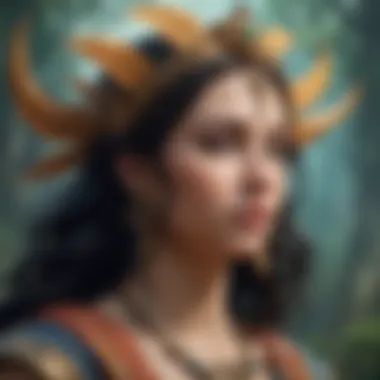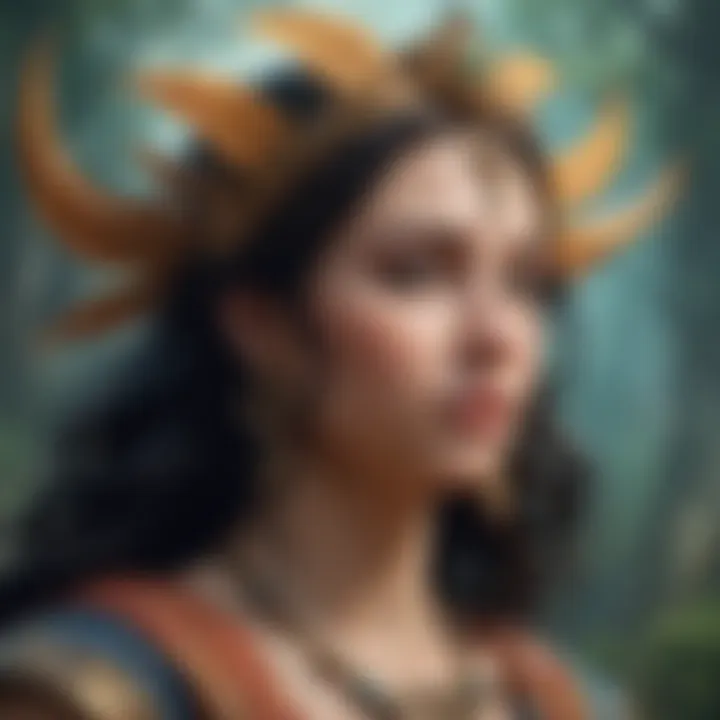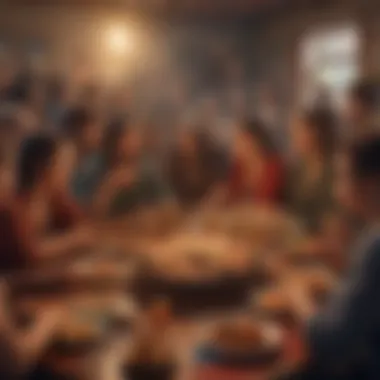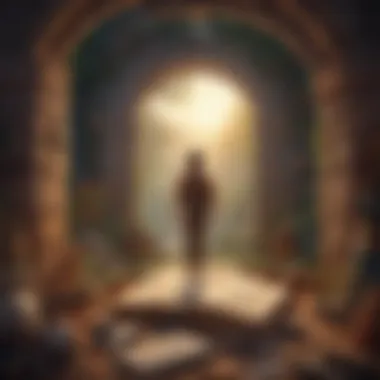The Influence of Myth on Culture and Identity


Intro
Myths are not just fanciful stories whispered around fire pits in ancient times. They are powerful narratives woven into the very fabric of human cultures, shaping our thoughts, behaviors, and beliefs. This article sets out to explore the intricate world of myths, revealing their depths and the profound influence they wield over society and psychology. We’re diving into a comprehensive study that traverses the historical origins of myths and their enduring relevance in our modern lives.
As we peel back the layers, we’ll examine how myths serve as tools for meaning-making, helping individuals forge their identities within their cultural backdrops. Furthermore, the article will delve into the psychological underpinnings of myths, showcasing how they address existential questions that humanity grapples with, and traces as well their significant roles in literature, art, and social frameworks. Through this exploration, we hope to illuminate the reason why myths continue to resonate, echoing in our lives today.
Preamble to Myths
Understanding myths is like peeling an onion; every layer reveals deeper insights into human thought and culture. Myths do far more than simply tell stories; they help us make sense of our world. They shape values, ethics, and our perception of reality itself. As we wade through the history and nuances of myths, it’s essential to grasp their role not just as relics of the past but as vital parts of our societal fabric. This section sets the stage for a deeper dive into the compelling narratives that span countless cultures and epochs.
Defining Myth
At its core, a myth is a traditional story that embodies a culture's beliefs, values, and explanations for the universe. Some might argue that defining myth is akin to trying to catch smoke with your hands; it can elude precise definition yet remains palpably real. Myths often serve to explain the unexplainable—creation, natural disasters, or even societal norms. They are not mere fables but touchstones that reflect the human condition.
Myths can take many forms, from creation tales to hero journeys. These narratives are imbued with symbols and motifs that resonate across cultures. What is particularly fascinating is how these themes, such as the struggle between good and evil or the quest for knowledge, appear repeatedly throughout varied mythologies.
- Key components of myths include:
- Characters: Often heroes, gods, or legendary figures that the audience can look up to.
- Setting: Frequently in a time and place that feels both familiar and otherworldly.
- Moral or lesson: Providing wisdom or answers to existential questions.
Ultimately, myths function as mental scaffolding for humanity, guiding us through experiences and offering frameworks to interpret our lives.
Historical Context of Myths
Taking a step back, historical context sheds light on how myths evolved over the ages. The origins of myth can be traced to the time when oral tradition was paramount in storytelling. Societies relied on oral narratives to pass down knowledge before the invention of writing, making these stories the bedrock of cultural memory. They helped to forge communal identities, bonding people through shared tales and values.
In ancient civilizations, such as the Greeks and Egyptians, myths served not just as entertainment but as explanations for natural phenomena. For instance, the Greek myth of Persephone's descent into the underworld offers a narrative for the changing seasons, articulating a culture's understanding of life’s cyclical nature and agricultural cycles. Similarly, Native American legends often encapsulate relationships with nature and moral teachings.
In essence, myths reflect the unique historical and cultural landscapes they emerge from. Each story, birthed from distinct circumstances, provides insight into the philosophies and struggles of its people. Understanding this historical backdrop allows us to appreciate not only the narrative itself but also its significance in shaping collective identities.
"Myths are public dreams, dreams are private myths." — Joseph Campbell
In summary, exploring myths invites us into a rich tapestry of tradition and cultural expression, laying a foundation for further investigation of their implications, themes, and most importantly, their relevance today.
The Role of Myth in Culture
Myths serve not just as mere tales spun over campfires but as foundational threads woven into the very fabric of society. They furnish a lens through which individuals and communities can interpret their realities, navigate their existences, and make sense of the world around them. In this section, we’ll delve into how myths shape cultural identities and contribute to our understanding of shared experiences.
Myth as a Cultural Construct
At the heart of every culture lies its myths. These aren’t simply stories; they’re elaborate constructs that reflect the beliefs, values, and traditions of societies. Myths can coordinate a shared identity, binding individuals to their ancestry and heritage. They carry the whispers of history, physics, and morality, anchoring communities to their past and guiding them toward the future.
For instance, consider the tales of creation that permeate various cultures. These narratives not only attempt to explain origins but also embody the morals and ethics embraced by the people. Thus, myths become a means of cultural instruction, laying down the laws of behavior and societal norms.
Moreover, they are constantly evolving, adapting to changes in culture and society. This fluidity allows myths to remain relevant, addressing contemporary issues and concerns while still steeping in tradition. In this way, myths act as living entities, continually reshaping and reflecting the cultural landscape.
Myths Across Different Cultures
Exploring myths across cultures is nothing short of a grand journey through human imagination and experience. Each cultural myth sets itself apart through its distinct stories and paradigms, yet they all resonate with similar themes, such as creation and the hero's journey. Here, we will touch upon three prominent mythological traditions.
Greek Mythology
Greek mythology offers a treasure trove of narratives that have profoundly influenced Western literature and thought. The stories of gods like Zeus and mortal heroes like Hercules showcase the intricate dynamics between divinity and humanity. A key characteristic of Greek mythology is its anthropomorphism; gods displayed human weaknesses, allowing average people to relate to them on a personal level. This relatability fosters an understanding of human emotions in the broad spectrum, whether it be love, jealousy, or revenge.


The unique aspect of Greek mythology lies in its detailed and organized pantheon. The structured relationships among deities help articulate the complexities of human experiences and the natural world. However, some might argue that the specific cultural context may limit the global applicability of its lessons.
Native American Legends
Native American legends are rich narratives tied to nature and often embody the spiritual connection indigenous peoples have with their land. These stories carry lessons about respect, harmony, and balance, key elements for sustaining ecosystems and communities. The communal nature of these myths emphasizes oral tradition, where each retelling brings slight modifications, enhancing its relevance to the current audience.
A hallmark of Native American storytelling is its focus on cyclical time rather than linear progression, inviting a deeper reflection on existence and one’s place within it. While they encapsulate profound wisdom, some people might find these legends challenge Western interpretations of narrative structures, which can present a barrier to understanding for those unfamiliar with the context.
Asian Folklore
Asian folklore is incredibly diverse, comprising countless tales varying by region and culture—from the wisdom imparted through the tales of Confucius to the enchanting narratives of the Ramayana. A defining trait of Asian folklore is its integration of spirituality and moral lessons, often suggesting a path to enlightenment or understanding the universe. The complexity of these folk tales, often layered with symbolism and metaphysical themes, offers profound insights into human existence.
Another striking feature is how these myths often mirror philosophical ideas central to various Asian cultures, promoting harmony, respect for life, and the interconnectedness of all beings. However, the abstract nature of some narratives may prove challenging for audiences looking for straightforward interpretations.
In summary, exploring myths from different cultures reveals not only their distinct frameworks but also universal themes that resonate across human experiences. By delving into these rich traditions, we uncover insights that reinforce our understanding of life, identity, and the world we inhabit.
"Through the lens of culture, myths serve not merely as stories but as the essence of the human experience—a bridge between generations and an invitation to reflect on our existence."
Myth and Psychology
Myth serves not just as a narrative encapsulating human experience; it also functions deeply and intimately with the human psyche. In the interwoven dance of myth and psychology, we uncover a landscape where our motivations and dreams find structure, establishing a bridge between the external world and our inner experiences. The exploration of myths through a psychological lens opens up avenues of understanding how these stories resonate with our personal and collective lives.
Jungian Archetypes in Myths
When Carl Jung examined myths, he introduced the concept of archetypes—universal symbols and themes that recur across different cultures and times. These archetypes serve as narratives that mirror human nature, revealing our shared experiences and traumas. For example, the hero archetype is prevalent in many myths, from Hercules in Greek mythology to the character of Frodo in 'The Lord of the Rings.' Each figure, despite the distinct settings, embodies the struggle and journey inherent in the human experience.
Jung believed these archetypes are part of a collective unconscious that connects humanity. The power of these symbols lies in their ability to resonate with our personal experiences. They elicit a reaction that can be both emotional and intellectual. When readers confront these archetypes, it can stir latent thoughts or feelings, sometimes revealing truths about themselves they'd buried long ago. Thus, these deep-seated myths help people navigate their own lives because they see themselves reflected in the stories told for ages.
Myths as Psychological Tools
Myths act as mirrors that reflect personal and societal identity, often providing frameworks to help individuals make sense of their inner worlds. These frameworks are handy for processing complex emotions and experiences.
Personal Identity
Personal identity is a crucial aspect that myths illuminate, helping individuals piece together their sense of self. Myths often provide narratives that fill the gaps in our experiences, aligning with our aspirations and fears. By identifying with characters in these tales, individuals may find a sense of belonging and validation. The resilience and courage shown by mythological figures can motivate personal growth, as one might aspire to emulate these traits in their own life.
In contrast, there can be a downside to such identification. Over-reliance on mythical narratives may create unrealistic expectations or overshadow personal realities. It may lead to a disconnection from one’s own authentic experiences as one seeks to fit into archetypes that may not fully represent them. Nevertheless, in understanding personal identity through myths, individuals can explore who they are against a larger context, a powerful notion that resonates across cultures.
Collective Unconscious
The concept of the collective unconscious is another crucial element that enriches the discourse on myths and psychology. This theory posits that all humans share a set of memories and ideas, inherited throughout evolution. Myths tap into this depth, revealing the common threads of existence that bind people together across different civilizations. From creation myths like those of the Aboriginal peoples to the flood stories found in various cultures, these narratives highlight shared human experiences and fears.
These shared stories offer comfort and connection, underpinning societal values and norms. They remind us that, underneath it all, we are inextricably linked to one another through our shared challenges and dreams, a remarkable unifying force. Yet, the intricacy of the collective unconscious can also complicate individuality and cultural identity. It raises questions about how personal stories fit within these grand narratives. While it can empower, it may also feel like a weight, especially when one's individual experiences seem overshadowed by the archetypes themselves.
Narrative Structures in Myths
Understanding narrative structures in myths is like reading the blueprint of human storytelling. Every culture relies on stories to transmit values, teach lessons, and foster a sense of identity. Myths often employ distinct structures that allow them to convey complex ideas simply and powerfully. This section is essential as it highlights how myths shape our understanding of the world and our place in it.
When we dissect the elements of mythic narratives, we discover a tapestry woven from common themes and motifs. These structures are not just storytelling devices; they reflect deeper truths about existence, human behavior, and aspirations. By recognizing these patterns, readers can appreciate the layered meanings embedded in myths and how they resonate across time and cultures.
Common Themes and Motifs
Hero's Journey
The Hero's Journey is an archetypal structure that traces the path of a hero as they venture into the unknown, face trials, and ultimately return transformed. Its significance lies in its universal appeal. At its core, it represents the quest for identity and purpose, a theme that resonates with every reader and listener.


A key characteristic of the Hero’s Journey is its cyclical nature. This idea can be seen in many narratives ranging from ancient Greek epics like the "Odyssey" to modern tales such as "Star Wars." This structure is beneficial to our exploration because it illustrates how myths guide us through the complexities of life’s challenges.
A unique feature of the Hero's Journey is its focus on transformation. The protagonist often starts as an ordinary individual, confronting unfamiliar territory and challenges, eventually emerging with new insights. This transformation is both a personal journey and a reflection of collective human experience. However, one could argue that this model can sometimes oversimplify the tumultuous nature of real-life struggles, reducing multifaceted experiences to mere plot points.
Creation Myths
Creation Myths explore the origins of the universe, life, and humanity itself. These narratives address existential questions and reflect how different cultures seek to understand their beginnings. A hallmark of these myths is their ability to articulate a culture’s values and worldview, serving as a foundational narrative for a society.
Creation Myths are vital in our examination of myths, as they often reveal how human beings perceive the natural world and their place within it. For instance, in many Indigenous cultures, such tales emphasize harmony with nature rather than dominion over it, contrasting sharply with narratives from other cultures.
A unique aspect of Creation Myths is their diverse interpretations and adaptability, allowing them to evolve over time. While this attribute enhances relatability and depth, it might also lead to conflicting beliefs, creating tension within and between cultures.
Myths and Storytelling Techniques
The techniques employed in mythological storytelling, such as symbolism, foreshadowing, and moral lessons, are crucial in enhancing the narrative's power.
Symbolism adds layers of meaning, inviting audiences to look beyond the surface. For example, the phoenix represents rebirth, implying that destruction often leads to renewal.
Foreshadowing creates suspense, ensuring readers stay engaged. A hint dropped early on can reverberate throughout the tale, guiding audience interpretation and heightening the impact of the climax.
Lastly, moral lessons in myths serve as cautionary tales or guiding principles, contributing to the narrative's overall intent and reinforcing cultural values.
"Myths are not just stories; they are the lenses through which we view existence."
By examining these narrative structures, we uncover not just the frameworks of myths but also their enduring relevance. They are not mere relics of the past; they continue to inform our views today, steering the countless tales we create and share in our daily lives.
The Relevance of Myth Today
In a world overflowing with rapid advancements and shifting paradigms, the relevance of myth springs forth like a fount of wisdom. Myths are not mere relics of the past; they resonate in the fabric of today’s society, shaping our values, guiding our decisions, and providing a lens through which we view our experiences. They offer a roadmap through the complex terrain of modern life, helping individuals navigate everything from relationships to moral dilemmas.
The stories we tell, whether in casual conversations or grand narratives, draw heavily from mythological roots. The construction of identity, community engagement, and cultural transmission are all intricately interwoven with myth. They anchor us, reminding us of collective struggles and shared dreams. Understanding this relevance allows us to harness the power of myth to foster connection and instill a sense of belonging in our increasingly fragmented world.
Myths in Modern Literature
In literature, myths have shed their ancient skins only to emerge in contemporary forms. Modern writers draw inspiration from age-old tales, reinterpreting them to reflect current societal issues. For instance, novels like Circe by Madeline Miller breathe new life into Greek mythology, reflecting themes of feminism and identity. Through this lens, readers glean insights that resonate on personal and collective levels.
Moreover, the retelling of myths in a modern context allows readers to explore familiar archetypes in unfamiliar settings. This not only revitalizes the tales but also promotes a richer dialogue regarding their significance today. Whether it's a character grappling with a tragic flaw or the classic hero's journey, these narratives continue to mirror our own struggles and triumphs, acting as a bridge between what was and what could be.
Myth and Popular Culture
Popular culture, a vibrant tapestry of beliefs and practices, serves as a stage where myths continue to thrive. This interplay is essential as it reflects and shapes public consciousness.
Film and Television
Film and television act as significant conduits for myth. They revive age-old themes, presenting them through modern storytelling techniques. Consider how the Marvel Cinematic Universe draws heavily on mythological elements—from heroes with larger-than-life abilities to epic confrontations between good and evil. This not only captivates audiences but also allows for deeper conversations about morality, power, and the human condition.
One of the key characteristics of film and television is their visual storytelling, a potent tool in portraying complex narratives in an accessible way. They can bring visceral emotions to life, enabling viewers to connect deeply with characters' journeys. However, there is a disadvantage in oversimplification. Myths often carry nuanced meanings that can't always be effectively captured in a two-hour movie or episodic format. Yet, these visual mediums succeed in sparking interest, leading audiences back to the original tales for deeper understanding.
Video Games
Video games have surged as a unique platform for exploring myth. The God of War franchise, for instance, delves into Norse and Greek mythology, enabling players to engage directly with mythological figures and their stories. This interactive element transforms the consumption of stories into participation, allowing for a personal experience with the narrative.
The characteristic of agency in video games offers players an opportunity to make choices that affect the outcome of the story, much like the heroes of ancient myths faced choices that defined their paths. However, the downside can be that not all players may reflect on the mythological elements as intended, sometimes viewing them merely as mechanics for gameplay rather than vehicles for deeper meanings. Despite this, the reflective and participatory nature of gaming creates a powerful opportunity for myth to resonate with a younger audience.
Interpreting Myths Through a Contemporary Lens


When we think about myths, the first thing that often crosses our minds is ancient tales of gods, heroes, or even fables that made people tick in yesteryears. However, the interpretation of these stories should not merely reside in the pages of history. Understanding myths through a contemporary lens means more than nostalgia for times gone by; it invites us to carefully consider how these narratives resonate in today's complex world.
The contemporary interpretation of myths reveals their evergreen relevance. By digging into these tales, we can extract values, themes, and questions that still motivate human behavior, social constructs, and moral dilemmas today. This analysis equips us with the ability to reflect on personal and collective identities in a world that often feels fragmented or chaotic.
Reimagining Myths
Reimagining myths involves more than a retelling; it's about transforming the core of these stories to make them applicable to modern life. Think of the classic Hero’s Journey. Each generation can reinterpret the hero archetype based on current challenges and aspirations. In today’s context, heroes might not wear capes or ride horses; rather, they could be activists fighting for social justice, innovators reshaping technology, or even everyday individuals battling personal hardships.
Moreover, reimagining myths allows authors and artists to weave contemporary issues into traditional narratives. Consider the way some modern adaptations mix ancient Greek myths with themes like gender fluidity, environmentalism, and mental health. This kind of creative engagement breathes new life into age-old stories, allowing them to resonate with younger audiences who might struggle to find themselves in the original tales.
"Myths are not just stories; they are a prism through which we can view the complexities of life even in the present day."
Myths in Educational Contexts
The place of myths in education is both profound and critical. They can serve as a significant educational tool, influencing how we approach learning and knowledge. When myths are integrated into educational curricula, they provide context and depth to core subjects, from literature to history and even science.
In literature classes, exploring different myths can ignite discussions about themes like heroism, morality, and the human condition. In history, myths reflect the cultural values and social norms of the times they originate from. In science education, some myths can inspire curiosity about human nature, ethics, and the universe itself.
Furthermore, using myths, educators can foster critical thinking. Students analyzing, critiquing, or adapting these stories learn to engage with complex ideas constructively. This not only enhances their understanding of literature but also equips them with valuable skills in interpretation, empathy, and societal awareness.
In short, interpreting myths through a contemporary lens provides a tapestry of understanding that is as rich as it is essential. By continuing to engage with these narratives, we bridge the gap between past and present, allowing us to better navigate our future.
The Future of Myth
As we navigate through the complexities of modern life, the role of myth continues to be significant, evolving in response to cultural, social, and technological changes. Myths have traditionally served as a means of understanding the world and our place within it, and their transformation in contemporary society reflects shifting human values and experiences. In this section, we will explore the evolving nature of myth and examine how technology is reshaping myths for future generations.
Evolving Mythologies
Myths are not static; they live and breathe, adapting with each generation. The myths of the past often reflect the values, fears, and aspirations of their time. Today, we see new narratives emerging that resonate with contemporary issues. For instance, environmental myths arise in response to climate change and ecological crises. These newer stories question the harmony between humanity and nature, reshaping our understanding of stewardship and responsibility.
Interestingly, these evolving stories often blend ancient mythological themes with modern twist. Consider how figures like Prometheus, who stole fire for humanity, morph into contemporary beings like climate activists or innovative scientists fighting against the odds for a better future. This interplay showcases our desire to find meaning and heroism in current struggles, suggesting that myths can be engines of cultural evolution.
Running parallel to this is the emergence of personal myths in a world saturated with narratives. People increasingly tailor their identities to fit personal experiences while borrowing themes from broader cultural myths. This process of self-mythologizing allows individuals to connect their stories with a larger human experience, cultivating a sense of belonging and purpose in a fractured world.
The Impact of Technology on Myths
In today’s digital age, technology is a double-edged sword when it comes to understanding and disseminating myths. On one hand, it democratizes content creation, allowing individuals to share and reinterpret myths in novel ways. For example, social media platforms give rise to viral stories that, while sometimes fleeting, can echo mythic structures by capturing and cementing collective emotions and beliefs in real-time.
However, the ease of spreading information also leads to the challenge of misinformation and diluted narratives. Traditional gatekeepers of myths—like scholars and storytellers—are increasingly sidelined, allowing for a mishmash of ideas that can distort original meanings. As technology continues to rapidly evolve, the potential for myths to become fragmented or commercialized demands careful attention.
"Myths have the power to shape our realities, but in the age of technology, they also risk becoming mere commodities."
Moreover, technology opens doors to new formats for mythical storytelling. Animation, virtual reality, and interactive games allow audiences to engage with myths in immersive ways. This can deepen one’s connection to these stories, as an individual may actively participate in the narrative, creating a deeper bond to the mythic themes conveyed.
Ultimately, the future of myth lies not just in its evolution but also in our ability to critically engage with these stories. By understanding both the potential and the pitfalls brought on by technological advances, we can ensure that myths serve not only as entertainment but as a profound means of enlightenment for generations to come.
By examining these aspects, readers can appreciate the dynamic nature of myths and consider their role in shaping personal and collective identities in an increasingly complex world.
Finale: The Enduring Power of Myth
The closing chapter of this exploration into myths urges us to reflect deeply on their lasting significance in our lives. Myths, far from being mere stories, are threads sewn into the very fabric of human existence, influencing our beliefs, actions, and understanding of the world. As we've traversed through various sections, from the historical context that birthed these narratives to their psychological implications today, it becomes increasingly clear that myths serve not only as cultural artifacts but also as vessels for meaning and wisdom.
Reflecting on the significance of myths unveils several key elements:
- Cultural Reflection: Each myth carries with it the essence and ethos of the society from which it originates, presenting a mirror that reflects the values, struggles, and aspirations of people across time and space.
- Psychological Insights: The stories embed universal human experiences, addressing fundamental questions about life, identity, and morality. They act as compasses for individuals navigating the complexities of existence.
- Artistic Inspiration: Myths have been a wellspring for artists, writers, and creators throughout history. Their rich imagery and timeless themes continue to inspire new interpretations that resonate with contemporary audiences.
- Promoting Understanding: In a world increasingly defined by differences, myths offer a platform for common understanding. They remind us of shared narratives that can bridge cultures and foster empathy and connection.
"A myth means more than a story: it reveals a truth about the human experience that transcends time and geography."
As we consider the evolving landscape of society—where technology and globalization intertwine with tradition—it's evident that myths remain pertinent. They adapt and transform, yet their core functionality persists: to assist us in making sense of the human condition and to guide future generations through the maze of life.
In closing, the enduring power of myth lies not just in their ability to entertain but in their capacity to enlighten. They connect us to our past, enrich our present, and inform our future, making them an indispensable part of the human narrative.



